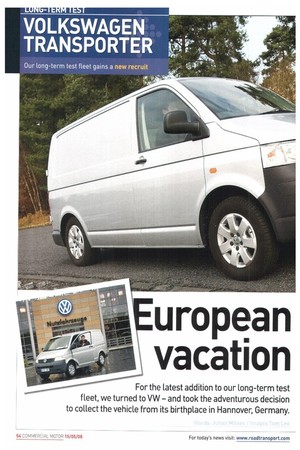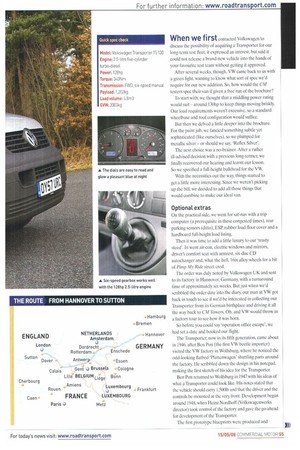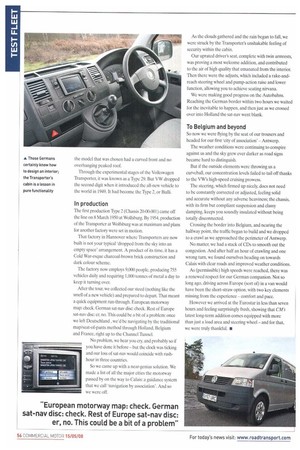uropean vacation
Page 54

Page 55

Page 56

If you've noticed an error in this article please click here to report it so we can fix it.
For the latest addition to our long-term test fleet, we turned to VW and took the adventurous decision to collect the vehicle from its birthplace in Hannover, Germany.
When we first contacted Volkswagen to discuss the possibility of acquiring a Transporter for our long-term test fleet, it expressed an interest, but said it could not release a brand-new vehicle into the hands of your favourite test team without getting it approved.
After several weeks, though, VW came back to us with a green light, wanting to know what sort of spec we'd require for our new addition. So, how would the CM testers spec their van if given a free run of the brochure?
To start with, we thought that a middling power rating would suit around 130hp to keep things moving briskly. Our load requirements weren't excessive, so a standard wheelbase and roof contiguration would suffice.
But then we delved a little deeper into the brochure. For the paint job, we fancied something subtle yet sophisticated (like ourselves), so we plumped for metallic silver or should we say, 'Reflex Silver'.
The next choice was a no-brainer. After a rather ill-advised decision with a previous long-termer, we finally recovered our hearing and learnt our lesson. So we specified a full-height bulkhead for the VW.
With the necessities out the way, things started to get a little more interesting. Since we weren't picking up the bill, we decided to add all those things that would combine to make our ideal van.
Optional extras
On the practical side, we went for sat-nay with a trip computer (a prerequisite in these congested times), rear parking sensors (ditto). ESP, rubber load floor cover and a hardboard full-height load lining.
Then it was time to add a little luxury to our 'trusty steed'. In went air-con, electric windows and mirrors, driver's comfort seat with armrest, six-disc CD autochanger and, what the hell, 16in alloy wheels for a bit of Pimp My Ride street cred.
The order was duly noted by Volkswagen UK and sent to its factory in Hannover, Germany, with a turnaround time of approximately six weeks. But just when we'd scribbled the order date into the diary, our man at VW got back in touch to see if we'd be interested in collecting our Transporter from its German birthplace and driving it all the way back to CM lowers. Oh, and VW would throw in a facton,, tour to see how it was born.
So before you could say 'operation office escape', we had set a date and booked our flight.
The Transporter, now in its fifth generation, came about in 1946, after Ben Pon (the first VW beetle importer) visited the VW factory in Wolfsburg, where he noticed the odd-looking flatbed 'Plattenwagen' shuttling parts around the factory. He scribbled down the design in his notepad, making the first sketch of his idea for the Transporter.
Ben Pon returned to Wolfsburg in 1947 with his ideas of what a Transporter could look like. His notes stated that the vehicle should carry 1,500lb and that the driver and the controls be mounted at the very front. Development began around 1948, when Heinz Nordhoff (Volkswagenwerks director) took control of the factory and gave the go-ahead for development of the Transporter.
The first prototype blueprints were produced and the model that was chosen had a curved front and no overhanging peaked roof.
Through the experimental stages of the Volkswagen Transporter, it was known as a Type 29. But VW dropped the second digit when it introduced the all-new vehicle to the world in 1949. It had become the Type 2, or Bull.
In production The first production Type 2 (Chassis 20-00-001) came off the line on 8 March 1950 at Wolfsburg. By 1954, production of the Transporter at Wolfsburg was at maximum and plans for another factory were set in motion.
That factory in Hannover where Transporters are now built is not your typical 'dropped from the sky into an empty space' arrangement. A product of its time, it has a Cold War-esque charcoal-brown brick construction and dark colour scheme.
The factory now employs 9,000 people, producing 755 vehicles daily and requiring 1,000 tonnes of metal a day to keep it turning over.
After the tour, we collected our steed (nothing like the smell of a new vehicle) and prepared to depart. That meant a quick equipment run-through. European motorway map: check. German sat-nay disc: check. Rest of Europe sat-nay disc: er, no. This could be a bit of a problem: once we left Deutschland ,we'd be navigating by the traditional map/seat-of-pants method through Holland, Belgium and France, right up to the Channel Tunnel.
No problem, we hear you cry, and probably so if you have done it before — but the clock was ticking and our loss of sat-nay would coincide with rushhour in three countries.
So we came up with a near-genius solution. We made a list of all the major cities the motorway passed by on the way to Calais: a guidance system that we call 'navigation by association'. And so we were off. As the clouds gathered and the rain began to fall, we were struck by the Transporter's unshakable feeling of security within the cabin.
Our uprated driver's seat, complete with twin armrests, was proving a most welcome addition, and contributed to the air of high quality that emanated from the interior. Then there were the adjusts, which included a rake-andreach steering wheel and pump-action raise and lower function, allowing you to achieve seating nirvana.
We were making good progress on the Autobahns. Reaching the German border within two hours we waited for the inevitable to happen, and then just as we crossed over into Holland the sat-nay went blank.
To Belgium and beyond So now we were flying by the seat of our trousers and headed for our first 'city of association' — Antwerp.
The weather conditions were continuing to conspire against us and the sky grew ever darker as road signs became hard to distinguish.
But if the outside elements were throwing us a curveball, our concentration levels failed to tail off thanks to the VW's high-speed cruising prowess.
The steering, which firmed up nicely, does not need to be constantly corrected or adjusted, feeling solid and accurate without any adverse heaviness; the chassis, with its firm but compliant suspension and classy damping, keeps you soundly insulated without being totally disconnected.
Crossing the border into Belgium, and nearing the halfway point, the traffic began to build and we dropped to a crawl as we approached the perimeter of Antwerp.
No matter, we had a stack of CDs to smooth out the congestion. And after half an hour of crawling and one wrong turn, we found ourselves heading on towards Calais with clear roads and improved weather conditions.
As (permissible) high speeds were reached, there was a renewed respect for our German companion. Not so long ago, driving across Europe (sort of) in a van would have been the short-straw option, with two key elements missing from the experience — comfort and pace.
However we arrived at the Eurostar in less than seven hours and feeling surprisingly fresh, showing that CM'S latest long-term addition comes equipped with more than just a load area and steering wheel — and for that, we were truly thankful. •




























































































































































































